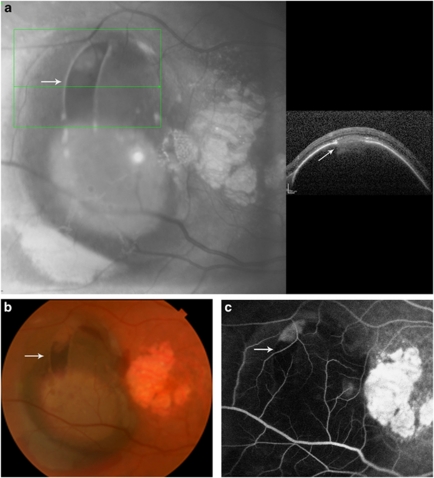Sir,
Case report
A 74-year-old Caucasian female with history of advanced age-related macular degeneration presented with decreased vision in the right eye. The patient was treated with two ranibizumab injections for choroidal neovascularization 5 months prior without improvement. Subsequently, two bevacizumab injections were administered over 2 months with the last one being 4 weeks ago. On examination, visual acuity was 20/50 in the right eye and CF at 2 ft in the left. The left eye had a disciform scar due to choroidal neovascularization. Best-corrected visual acuity was 20/40 in the right eye 1 month ago. Fundus examination showed a well-demarcated area of geographic atrophy, an elevated lesion (characteristic of pigment epithelial detachment (PED)) with haemorrhages at the periphery and sub-retinal fluid. In addition, there was a lesion in the posterior pole clinically resembling a retinal tear. Spectral domain optical coherence tomography (OCT) confirmed a retinal pigment epithelial (RPE) tear with intact retina. Figure 1 shows the SD-OCT with a hyperflourescent layer, representing the RPE layer. There is a focal disruption in the RPE with the overlying retinal integrity maintained. The patient was observed closely and bevacizumab injections were continued monthly. The patient's vision has remained stable in the right eye for 5 months.
Figure 1.
(a) SD-OCT showing RPE defect with overlying intact retina. (b) Fundus photograph showing geographic atrophy and elevated lesion with RPE tear resembling retinal tear in the posterior pole. (c) Fluorescein angiography.
Comment
The incidence of RPE tear is 1–27% following treatment with anti-VEGF therapy.1, 2, 3 RPE tears are most often associated with PED,1 with height and diameter of PED reported as risk factors.3, 4 After anti-VEGF injections, tears are attributed to the rapid contraction of the neovascular membrane resulting in significant tangential stress on the RPE.1 They are reported to occur most often between 4 and 8 weeks of initiation of anti-VEGF therapy,1, 5 such as in our patient. Although RPE tears occur spontaneously, the temporal relationship between the anti-VEGF injection and the tear must be taken into consideration. Treatment of RPE tear is not well established. However, similar to our patient, continuation of anti-VEGF therapy has been reported to stabilise visual acuity.1 Vision should improve provided the fovea is not involved.2
Acknowledgments
We acknowledge funding support from the following sources: NEI/NIH, Research to Prevent Blindness, VA Merit Award, San Diego Clinical and Translational Research Institute ITL1RR031979-01, and Macula Vision Research Foundation.
The authors declare no conflict of interest.
References
- Chang LK, Sarraf D. Tears of the retinal pigment epithelium: an old problem in a new era. Retina. 2007;27:523–534. doi: 10.1097/IAE.0b013e3180a032db. [DOI] [PubMed] [Google Scholar]
- Sarraf D, Reddy S, Chiang A, Yu F, Jain A. A new grading system for retinal pigment epithelial tears. Retina. 2010;30 (7:1039–1045. doi: 10.1097/IAE.0b013e3181cdf366. [DOI] [PubMed] [Google Scholar]
- Smith BT, Kraus CL, Apte RS. Retinal pigment epithelial tears in ranibizumab-treated eyes. Retina. 2009;29 (3:335–339. doi: 10.1097/IAE.0b013e318195cad5. [DOI] [PubMed] [Google Scholar]
- Chan CK, Abraham P, Meyer CH, Kokame GT, Kaiser PK, Rauser ME, et al. Optical coherence tomography-measured pigment epithelial detachment height as a predictor for retinal pigment epithelial tears associated with intravitreal bevacizumab injections. Retina. 2010;30 (2:203–211. doi: 10.1097/IAE.0b013e3181babda5. [DOI] [PubMed] [Google Scholar]
- Chan CK, Meyer CH, Gross JG, Abraham P, Nuthi AS, Kokame GT, et al. Retinal pigment epithelial tears after bevacizumab injection for neovascular age-related macular degeneration. Retina. 2007;27:541–551. doi: 10.1097/IAE.0b013e3180cc2612. [DOI] [PubMed] [Google Scholar]



